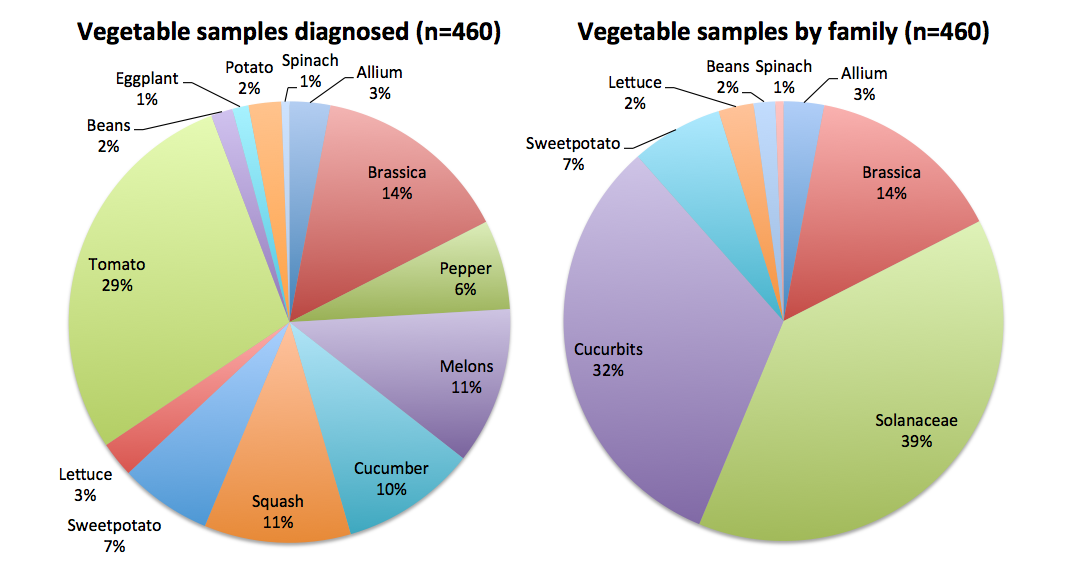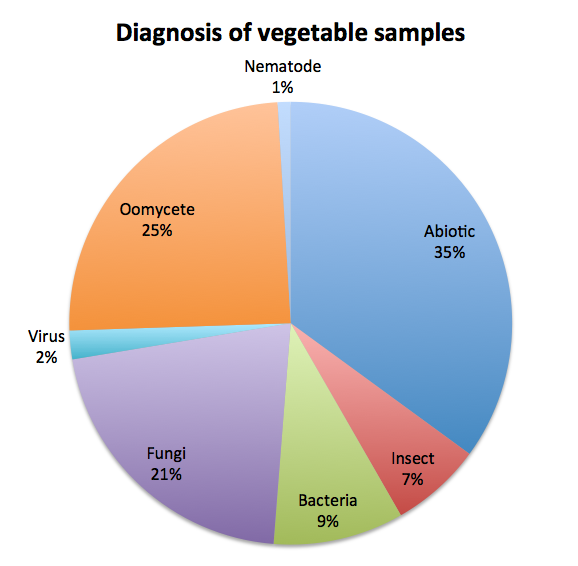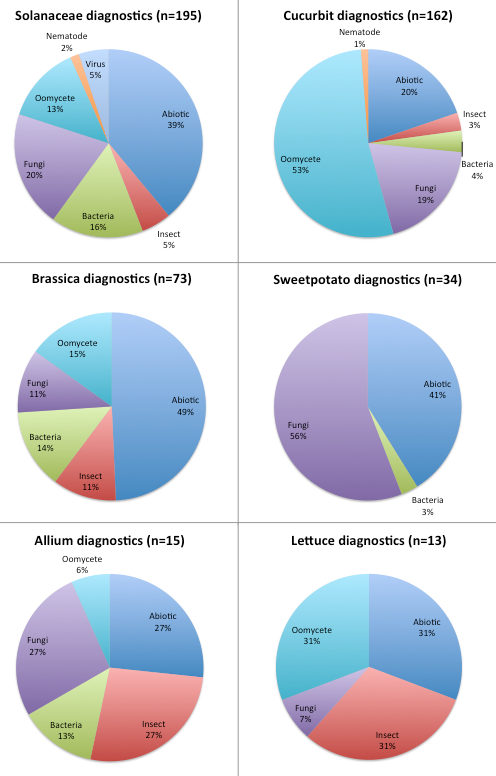By Lina Quesada-Ocampo
The Vegetable Pathology lab at NCSU works in collaboration with the Plant Disease and Insect Clinic to diagnose vegetable diseases and provide disease management recommendations. We have compiled a report to provide our stakeholders with information of some of the trends we observed last year that could help us foresee disease outbreaks for 2014.
Vegetable diseases during 2013
The clinic received approximately 460 vegetable samples last year. Figure 1 shows the percentages of vegetables grouped by type/family, and shows that the majority of samples diagnosed last year were solanaceous (tomato, potato, pepper, eggplant) and cucurbit (melons, squash, cucumber) crops, followed by brassica crops (cabbage, broccoli, collards, turnip, kale), sweetpotatoes, allium crops (garlic, onion), lettuce, beans and spinach.

Figure 1: Vegetable samples by family or type diagnosed on 2013
As shown in Figure 2, the majority of samples (58%) were affected by a plant pathogen (oomycete, fungi, bacteria, virus or nematode). When we partition the diagnosis by type, the most frequent diagnosis during 2013 were abiotic causes (fertilization, soils, salts, water stress, injury, chemical burns, etc.), oomycete diseases (in order downy mildew, Phytophthora, and Pythium), and fungal diseases (in order Fusarium, anthracnose, Alternaria, and gummy stem blight). While 65 cucurbit samples infected by an oomycete were diagnosed through our work with the Cucurbit Downy Mildew IPM pipe, even after excluding these samples, downy mildews were the most predominant oomycete diagnosis last year in vegetable crops. However, after excluding these samples, fungal and not oomycete pathogens were the most frequent organisms diagnosed at the clinic as causing diseases last year. We also diagnosed some bacterial diseases such as bacterial leaf spots and fruit blotch, and a few virus and nematode-affected samples. Several samples submitted were affected by insect damage and no pathogens were found.

Figure 2: Diagnosis of vegetable samples during 2013
Figure 3 describes in more detail the results for diagnosed samples from the vegetable crops most frequently submitted to the clinic (solanaceae, cucurbits, brassicas, sweetpotatoes, alliums and lettuce). Solanaceous crops were mostly affected by abiotic problems and fungal diseases. In cucurbits, oomycete diseases were the most common cause of crop damage, and if we remove the cucurbit downy mildew samples, fungi and abiotic factors were the main cause of cucurbit disease. For brassica crops abiotic problems and oomycete diseases were the most frequent diagnosis. For sweetpotato more than half of the samples were affected by fungal diseases and others by abiotic causes. For allium and lettuce crops, the most common diagnosis was insect damage and abiotic problems, followed by fungal and oomycete diseases, respectively.

Figure 3: Diagnosis by vegetable type during 2013
What to expect for 2014
Last year we had a lot of rain, which unfortunately, favored several vegetable diseases throughout the state, and made crop protection and fertilization efforts difficult. For the coming year, we may still face some challenges as a result of last field season. Soil borne pathogen levels may have increased in fields and greenhouses that presented disease last year, the high levels of disease may have facilitated survival of pathogens in weeds and volunteer plants, and flooding may have allowed movement of soil borne pathogens into irrigation water sources or adjacent fields. Thus this coming year, is especially important that you take every precaution to avoid crop losses due to plant pathogens since conditions may be more conducive for disease than in previous years. Here are some things you can do to keep plant pathogens away from your operation:
Use pathogen-free seed and transplants. Try to avoid using seed from previous years to prevent any seed borne diseases, and if you must use seed from previous years consider chemical seed treatments to eliminate any pathogens in your seed. For diseases potentially being introduced into the field through contaminated seed or transplants such as gummy stem blight and black rot of cabbage, is important to start with pathogen-free material, destroy any seedlings showing symptoms of disease and all neighboring seedlings, and protect the seed and transplants with fungicides if possible.
Use appropriate growing practices for your crop. Provide adequate irrigation, fertilization and general growing conditions required for your crop. A vigorous plant will defend itself better from plant pathogens than one that is stressed. Vegetable crops are most susceptible to disease when there is an underlying abiotic stress or injury, thus, having good soil, fertilizing and insect control habits will result in a healthier crop.
Use crop rotation. If you experienced disease problems last year, rotate away from crops that are hosts of the pathogen found in your operation. It is important to accurately identify the affecting pathogen in your operation since it will dictate the appropriate rotational crop, some pathogens such as Pythium and Phytophthora capsici have a very broad host range which can limit the efficacy of crop rotation. A good tool to find out if a fungus or oomycete have been reported to infect a certain host in your state is the USDA ARS Fungal Database. Some growers have also used cover crops, solarization, fumigation, and grafting in cases were inoculum levels of soil borne pathogens are high to successfully reduce disease. You can also consider turning up the soil since most pathogens are found in the first 5-10 inches of soil, however, this will only be helpful for one year.
Click here to see more...